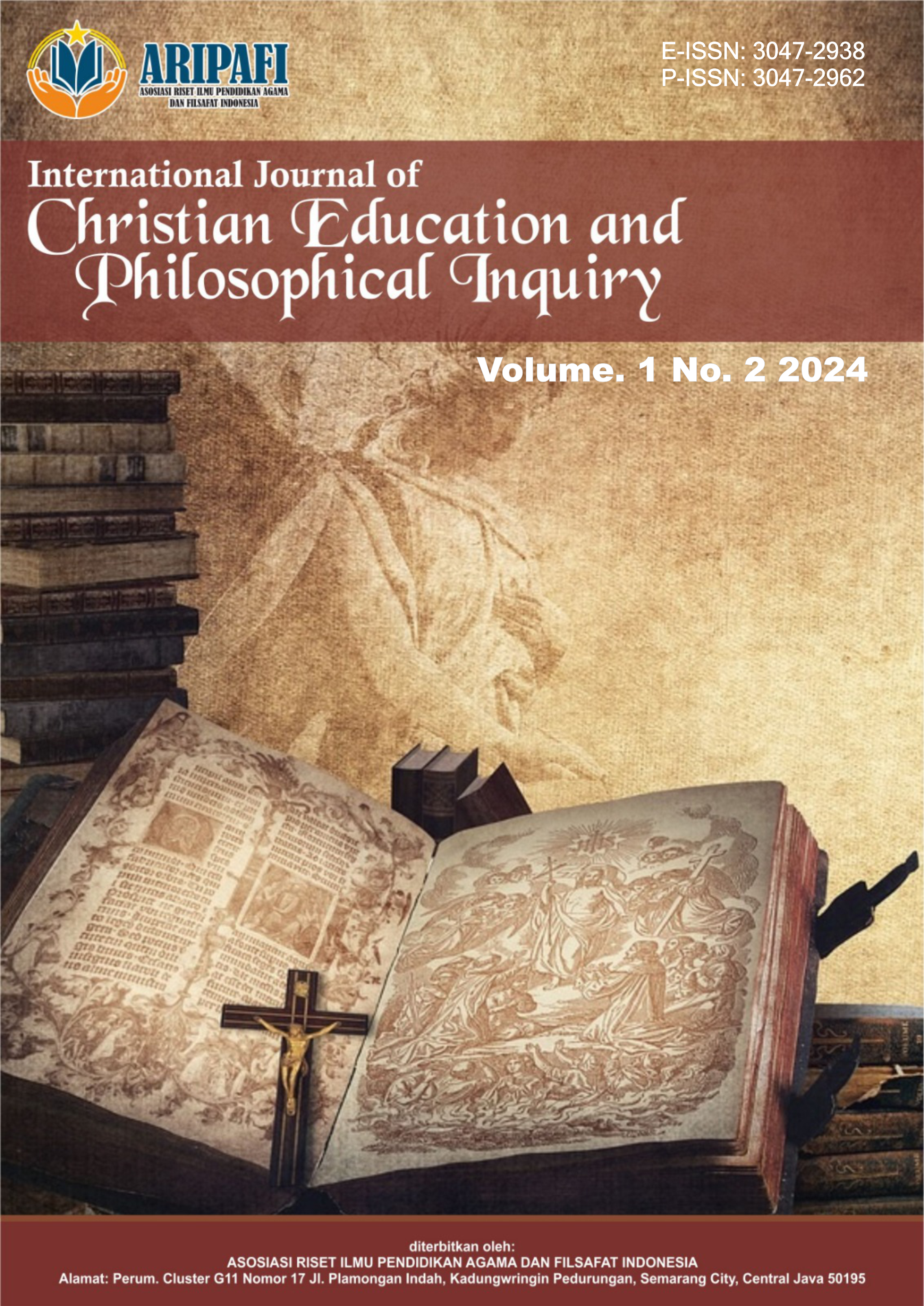Repentance And The Responsibility Of Holy Living For Believers
DOI:
https://doi.org/10.61132/ijcep.v1i2.23Keywords:
Repentance and Salvation, Image of God, Responsibility for holy livingAbstract
Repentance is needed because humans realize that they are sinners. Sinful people must be saved through repentance, without repentance sinful humans cannot be saved. Thus repentance has a strong connection with the salvation of believers. Salvation in the concept of the Old Testament people was to turn around and live in God's law. If they repent and obey, they will be saved, that is, they will be blessed with physical blessings such as victory over war, successful harvests, and being able to perform worship. On the other hand, if they do not repent of their sins, they will be condemned or cursed by God. This understanding of repentance and salvation has been adopted by adherents of prosperity theology. They say that Christians who have had their sins forgiven through repentance will be saved and live abundantly with physical blessings, success and prosperity. For the New Testament people, the goal of repentance and salvation is to achieve physical blessings like the Old Testament people or adherents of prosperity theology. This research tries to research and find the correct understanding of repentance and salvation which has implications for the responsibility of believers to maintain the holiness of their lives every day because humans are the holy image of God on this earth. The aim of this research is to find the true understanding of repentance and salvation in Christianity which has implications for the responsibility of Christians to live without falling into sin again or to live in the morality of God's holy holiness. The research in this paper uses a qualitative approach with the technique of writing a literature review or literature study. The research results show that the understanding of repentance and salvation to achieve the image of God who is in the image and likeness of God has implications for the responsibility of the congregation to achieve the morality of holiness like God. This research also shows that repentance is the renewal of the mind until it has thoughts and feelings like Christ. This research also found that the notion of repentance and salvation only by God's grace alone on the basis of damage to God's image in humans based on God's absolute sovereignty has no implications for the believer's responsibility to strive to live without sin or without blemish. Repentance is completely a gift where humans cannot exercise their free will to choose so that believers are not required to take a proportional responsibility to change their character based on individual decisions in order to live a holy life. Repentance in Christianity is no longer focused on physical blessings but on the restoration of God's image with the responsibility of the believer's holy life
References
Bavinck, Herman. (2012). Dogmatika Reformed, Allah dan Penciptaan: Allah dan Penciptaan Jilid 2 (Jilid 2). Surabaya: Momentum.
Boice, J. M. (2011). Dasar-dasar Iman Kristen. Momentum.
Boice, James Montgomery. (2011). Dasar-dasar Iman Kristen. Surabaya: Momentum.
Charles Hodge. (2012). Systematic Theology. Grand Rapids: B. Eerdmans Pubblishing.
Dominic Robinson. (2011). Understanding the “imago Dei”: The Thought of Bart, von Baltasar and Moltmann. ASHGATE.
Duyverman, M. E. (2013). Pembimbing ke dalam Perjanjian Baru. Jakarta: Gunung Mulia.
Enns, Paul. (2019). The Moody Handbook of Theology I. Malang: SAAT.
Erickson, Millard J.. (2015). Teologi Kristen: Volume Dua. Malang: Gandum Mas.
Gartner, B. (2006). New International Dictionary of New Testament Theology, peny., um., Colin Brown. Grand Rapids: Zondervan.
Guthrie, Donald. (2010). Pengantar Perjanjian Baru Volume 3, pen., Hendry Ongkowidjojo. Surabaya: Momentum.
Guthrie, Donald. (2014). Pengantar Perjanjian Baru. Surabaya: Momentum.
Sabdono, Erastus. (2016). Apakah Keselamatan Bisa Hilang? Rehobot Literature.
Sabdono, Erastus. (2017). Gambar Diri (Issue 1). Rehobot Literature.
Sabdono, Erastus. (2019). Anthopologi, Mengenal siapa dan bagaimana manusia menurut Alkitab. Jakarta: Rehobot Literatur.
Sabdono, Erastus. (2019). Apakah Keselamatan Bisa Hilang? Jakarta: Rehobot Literature.
Erickson, Millard J. (2015). Teologi Kristen: Volume Dua. Malang: Gandum Mas.
Hoekema, Anthony A. (2003). Manusia: Ciptaan menurut Gambar Allah. Surabaya: Momentum.
Lincoln, Iu. (2004). Discovering the Link Between Your Money and Faith. Discovering the Link Between Your Money and Faith. Teologi Kemakmuran, Jesus, Money and Me.
Robinson, D. (2013). Understanding the “imago Dei”: The thought of Barth, von Balthasar and Moltmann. In Understanding the “imago Dei”: The Thought of Barth, Von Balthasar and Moltmann.
Selderhuis, IMAGINUS. J. (2017). Buku Pegangan Calvin (Pertama). Surabaya: Momentum.
Telnoni, J.A. (2017). Tafsir Alkitab Kontekstual-Oikumenis, Kejadian Pasal 1-11, Jakarta: BPK Gunung Mulia.
Wahyu, R. (2007). Tobat - Pertobatan. Sarapanpagi.org.
Wahyu, R. (2019). Eksegesis Peshat Kitab Kejadian-Kitab Genealogi. Ekumene Literature.
Wijaya, IMAGINUS. (2012). Evaluasi Kritis Terhadap Doktrin Teologi Sukses. STT Jaffray Makassar
Busnitz, Nathan. dkk. (2021). The Substance of Sola Fide: Justification defended from Scripture in the writings of the reformers. TMS 32/1 p 90-92.
Djadi, Jermia. JURNAL JAFFRAY: Gambar dan Rupa Allah, Vol 2, No 1 (2004). DOI: http://dx.doi.org/10.25278/jj71.v2i1.14.
Jura, Demsy. (2017). Kajian Soteriologi dalam Teologi Universalisme, Calvinisme, dan Armeniamisme serta kaitannya dengan pembelajaran pendidikan agama Kristen. Shanan Jurnal Pendidikan Agam Kristen Vol. 1 No. 2 p 21-24.
Pasuhuk, Suryanica Aristas. Evaluasi Teologi Tiga Pandangan Manusia Dicptakan Menurut Gambar dan Rupa Allah. Jurnal Fakultas Filsafat (JFF) Universitas Klabat, Volume 1. No. 2 Desember 2012, p. 15-26. http://ejournal.unklab.ac.id/index.php/jff/article/view/326.
Von Dehsen, Christian D. (2007). The imago Dei in Genesis 1:26-27. Lutheran Quarterly Volume XI. P 259 – 267.
Wijaya, Hengky. Ekposisi Gambar Allah Menurut Penciptaan Manusia Berdasarkan Kejadian 1:26-28. https://repository.sttjaffray.ac.id/es/publications/269019/eksposisi-gambar-allah-menurut-penciptaan-manusia-berdasarkan-kejadian-126-28. Diakses tanggal 20 Mei 2021.
Zorgdrager, Heleen E. (2014). On the Fullness of Salvation: Tracking theosis in Reformed Theology. Journal of Reformed Theology 8 p 375-377.
Downloads
Published
How to Cite
Issue
Section
License
Copyright (c) 2024 International Journal of Christian Education and Philosophical Inquiry

This work is licensed under a Creative Commons Attribution-ShareAlike 4.0 International License.





